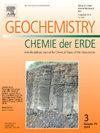Mineralogical and geochemical characteristics of AlFe granulites and banded iron formations in the Archean supracrustal unit of the In Ouzzal terrane (NW Hoggar, Algeria)
IF 2.9
3区 地球科学
Q2 GEOCHEMISTRY & GEOPHYSICS
引用次数: 0
Abstract
In the northern In Ouzzal terrane, Al![]() Fe granulites and banded iron formations (BIFs) constitute a supracrustal unit, locally associated with Al
Fe granulites and banded iron formations (BIFs) constitute a supracrustal unit, locally associated with Al![]() Mg granulites, marbles, calc-silicate granulites, and mafic or ultramafic rocks. The Al
Mg granulites, marbles, calc-silicate granulites, and mafic or ultramafic rocks. The Al![]() Fe granulites display variable SiO2 content (55.62 to 79.26 wt%) and XMg ratio (0.11–0.48) and are characterised by spinel–quartz parageneses, locally retrograded to garnet-sillimanite coronas. Cordierite is absent in some Al
Fe granulites display variable SiO2 content (55.62 to 79.26 wt%) and XMg ratio (0.11–0.48) and are characterised by spinel–quartz parageneses, locally retrograded to garnet-sillimanite coronas. Cordierite is absent in some Al![]() Fe granulite samples, while others contain cordierite-spinel or cordierite-spinel-orthopyroxene symplectites that are a breakdown product of spinel-garnet-sillimanite-quartz assemblages. The BIFs display a unique corundum-quartz-magnetite paragenesis, characteristic of ultra-high-temperature (UHT) metamorphic conditions. Another exceptionally rare type of BIF in the region consists of orthoferrosilite (XMg = 0.14–0.29) in equilibrium with high chlorine-rich (3.88 to 5.12 wt%) hastingsite, surpassing values reported in international literature. The Al
Fe granulite samples, while others contain cordierite-spinel or cordierite-spinel-orthopyroxene symplectites that are a breakdown product of spinel-garnet-sillimanite-quartz assemblages. The BIFs display a unique corundum-quartz-magnetite paragenesis, characteristic of ultra-high-temperature (UHT) metamorphic conditions. Another exceptionally rare type of BIF in the region consists of orthoferrosilite (XMg = 0.14–0.29) in equilibrium with high chlorine-rich (3.88 to 5.12 wt%) hastingsite, surpassing values reported in international literature. The Al![]() Fe granulites exhibit geochemical characteristics comparable to post-Archean shales and are interpreted as the products of mixed protoliths. These protoliths consist of mature detrital material, primarily quartz, derived from trondhjemite and tonalite sources emplaced between 3300 and 2700 Ma. Additionally, they include immature predominantly chloritic components enriched in Al, Cr (100–300 ppm) and V (100–200 ppm). Banded iron formations (BIFs) are mainly composed of three key components: SiO₂, FeO, and Fe₂O₃, with their combined content ranging from 91.51 to 99.23 wt%. The concentrations of Al₂O₃, TiO₂, CaO, and rare earth elements (REEs) are notably low, consistent with those of classic Archean BIFs. This composition implies that their formation resulted from the direct precipitation of Fe-rich minerals in oxidizing marine exhalative environments, while silica-rich layers (mainly chert) formed during periods of low oxygen concentration, and with the absence of detrital materials.
Fe granulites exhibit geochemical characteristics comparable to post-Archean shales and are interpreted as the products of mixed protoliths. These protoliths consist of mature detrital material, primarily quartz, derived from trondhjemite and tonalite sources emplaced between 3300 and 2700 Ma. Additionally, they include immature predominantly chloritic components enriched in Al, Cr (100–300 ppm) and V (100–200 ppm). Banded iron formations (BIFs) are mainly composed of three key components: SiO₂, FeO, and Fe₂O₃, with their combined content ranging from 91.51 to 99.23 wt%. The concentrations of Al₂O₃, TiO₂, CaO, and rare earth elements (REEs) are notably low, consistent with those of classic Archean BIFs. This composition implies that their formation resulted from the direct precipitation of Fe-rich minerals in oxidizing marine exhalative environments, while silica-rich layers (mainly chert) formed during periods of low oxygen concentration, and with the absence of detrital materials.
阿尔及利亚西北Hoggar in Ouzzal地块太古宙上地壳单元中AlFe麻粒岩和带状铁组的矿物学和地球化学特征
在In Ouzzal地体北部,AlFe麻粒岩和带状铁地层(BIFs)构成了一个上地壳单元,局部与AlFe麻粒岩、大理岩、钙硅酸盐麻粒岩和基性或超基性岩相关。AlFe麻粒岩SiO2含量(55.62 ~ 79.26 wt%)和XMg比值(0.11 ~ 0.48)变化较大,以尖晶石-石英共生岩为特征,局部向石榴石-硅线石冕状退变。一些AlFe麻粒岩样品中不含堇青石,而另一些样品中含有堇青石-尖晶石或堇青石-尖晶石-正辉石复合体,这些复合体是尖晶石-石榴石-硅石石-石英组合的分解产物。bif显示出独特的刚玉-石英-磁铁矿共生,具有超高温(UHT)变质条件。该地区另一种异常罕见的BIF类型由正硅铁矿(XMg = 0.14-0.29)与高富氯(3.88 - 5.12 wt%) hastingsite平衡组成,超过了国际文献报道的值。AlFe麻粒岩具有类似太古宙后页岩的地球化学特征,是混合原岩的产物。这些原岩由成熟的碎屑物质组成,主要是石英,来自于3300 - 2700 Ma之间的闪长岩和闪长岩。此外,它们还包括未成熟的主要绿藻成分,富含Al, Cr (100-300 ppm)和V (100-200 ppm)。带状铁地层(BIFs)主要由三种关键成分组成:SiO₂,FeO和Fe₂O₃,它们的总含量从91.51%到99.23%不等。Al₂O₃、TiO₂、CaO、稀土元素(ree)的浓度均较低,与太古宙经典if相一致。这一组成表明,它们的形成是由富铁矿物在氧化性海洋呼出环境中直接沉淀而成,而富硅层(主要是燧石层)形成于低氧浓度时期,没有碎屑物质。
本文章由计算机程序翻译,如有差异,请以英文原文为准。
求助全文
约1分钟内获得全文
求助全文
来源期刊

Chemie Der Erde-Geochemistry
地学-地球化学与地球物理
CiteScore
7.10
自引率
0.00%
发文量
40
审稿时长
3.0 months
期刊介绍:
GEOCHEMISTRY was founded as Chemie der Erde 1914 in Jena, and, hence, is one of the oldest journals for geochemistry-related topics.
GEOCHEMISTRY (formerly Chemie der Erde / Geochemistry) publishes original research papers, short communications, reviews of selected topics, and high-class invited review articles addressed at broad geosciences audience. Publications dealing with interdisciplinary questions are particularly welcome. Young scientists are especially encouraged to submit their work. Contributions will be published exclusively in English. The journal, through very personalized consultation and its worldwide distribution, offers entry into the world of international scientific communication, and promotes interdisciplinary discussion on chemical problems in a broad spectrum of geosciences.
The following topics are covered by the expertise of the members of the editorial board (see below):
-cosmochemistry, meteoritics-
igneous, metamorphic, and sedimentary petrology-
volcanology-
low & high temperature geochemistry-
experimental - theoretical - field related studies-
mineralogy - crystallography-
environmental geosciences-
archaeometry
 求助内容:
求助内容: 应助结果提醒方式:
应助结果提醒方式:


